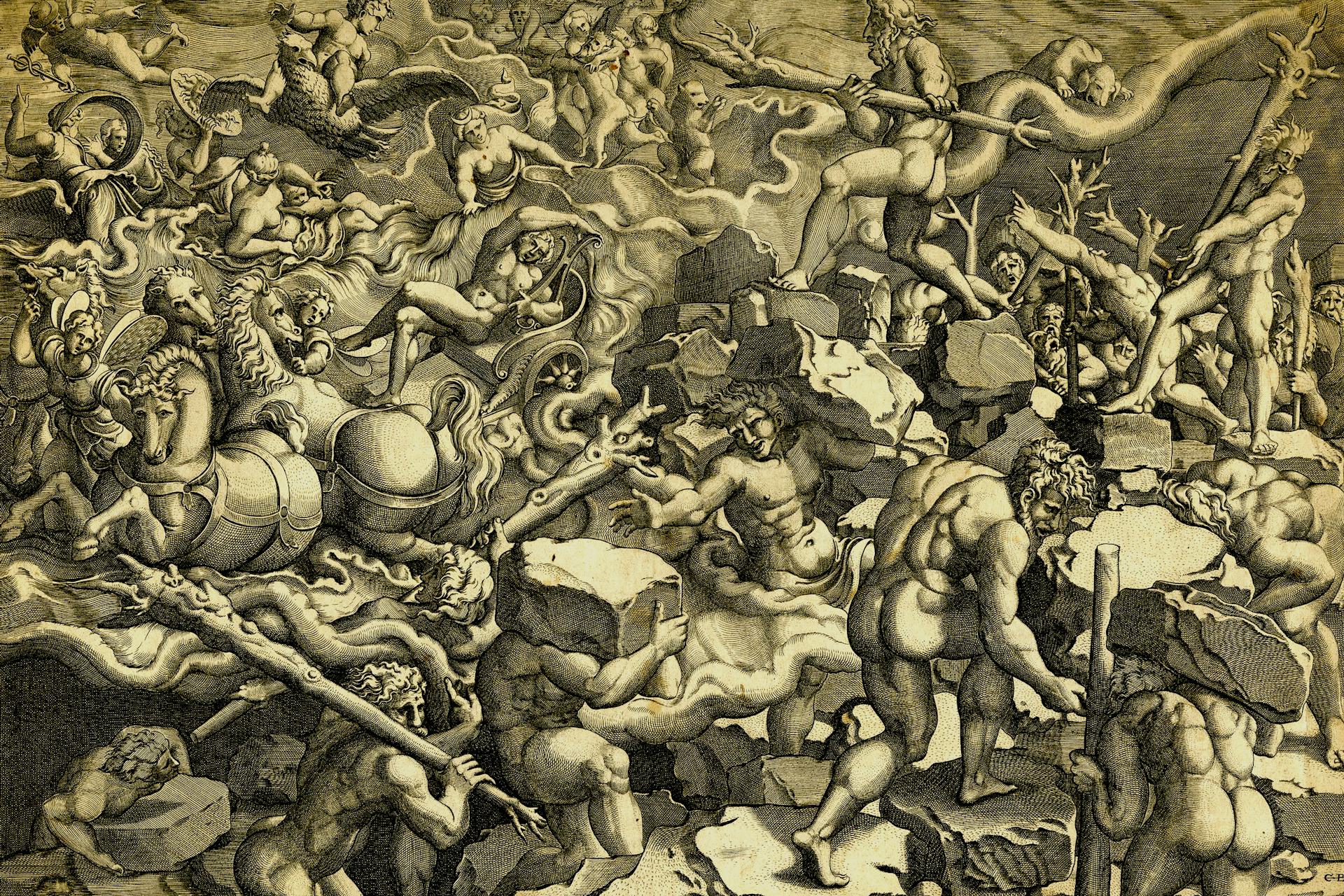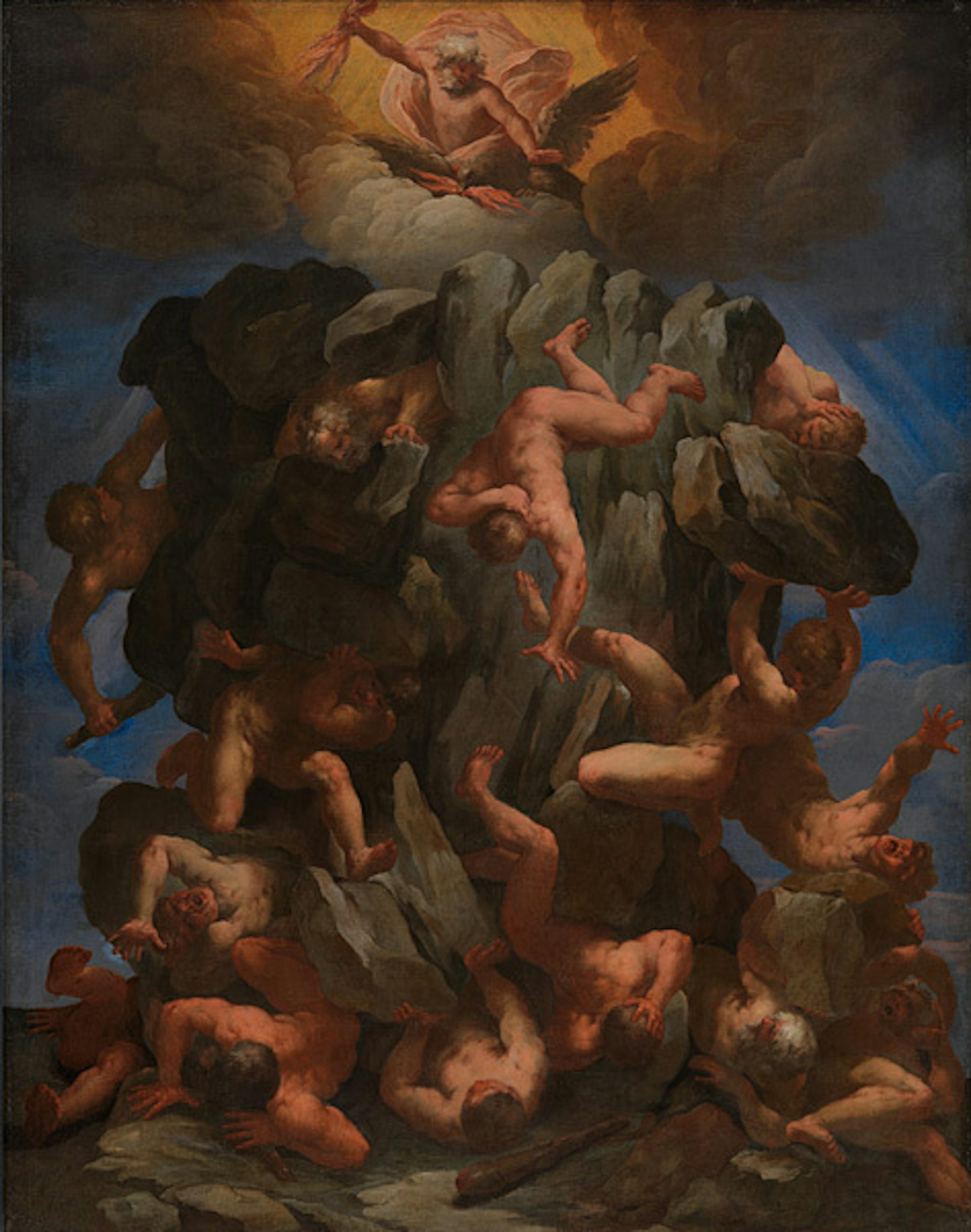Porphyrion

The Fall of the Giants by Cornelis Bos, after Giulio Romano (ca. 1530–56).
British MuseumPublic DomainOverview
Porphyrion was the most powerful of the Giants—violent children of the earth goddess Gaia who challenged the Olympian gods in a war known as the “Gigantomachy.” Porphyrion, along with his brother Alcyoneus, led the Giant army into battle against the Olympians in the Thracian town of Pallene (or Phlegrae). But the Giants were ultimately defeated, and Porphyrion himself was killed by either Zeus, Heracles, or Apollo (depending on the version).
Etymology
The name “Porphyrion” (Greek Πορφυρίων, translit. Porphyríōn; also spelled Πορφυρίον/Porphyríon or Φροφυρίον/Phorphyríon) is connected to the Greek word πορφύρεος (porphýreos), meaning “purple.” This most likely reflects Porphyrion’s role as the king of the Giants: because purple dye was extremely expensive to manufacture in antiquity, purple came to be regarded as an inherently kingly color.[1]
Pronunciation
English
Greek
Porphyrion Πορφυρίων (translit. Porphyríōn) Phonetic
IPA
[pawr-FEER-ee-uhn] /pɔrˈfɪər i ən/
Attributes
General
Porphyrion was one of the Giants (or “Gigantes”), strong and violent children of Gaia best known for waging a war against the Olympians. In early art and literature, the Giants were usually imagined as heavily armored warriors who looked more or less like ordinary humans. But it soon became more common to represent them as monstrous creatures—human from the waist up but with serpents for feet.
Porphyrion was one of the strongest of the Giants. He was usually called their leader as well—a role he was sometimes said to share with his brother Alcyoneus.[2] According to most sources, Porphyrion was born in Pallene or Phlegrae, a city in Thrace, where he lived with the other Giants.[3]
Iconography
Like his Giant brethren, Porphyrion’s image in ancient art varied over time. In early art, he typically had the appearance of an ordinary human, but after the fourth century BCE it became more common to represent him as a grotesque creature, with serpents in place of feet.
Porphyrion often appeared in artistic depictions of the Gigantomachy, an extremely popular subject in ancient art. He was always shown as the opponent of Zeus.[4]
Family
Family Tree
Parents
Fathers
Mother
Siblings
Brothers
Sisters
Mythology
The Gigantomachy
Porphyrion’s only mythological role was the one he played in the Gigantomachy (the war between the Giants and the gods). Spurred on by their mother Gaia, who hated the Olympians, the Giants attempted to defeat the gods and become rulers of the cosmos in their stead.
Upon learning that only a mortal could defeat the Giants, the gods enlisted the assistance of Heracles, the strongest mortal hero of all. When both sides had assembled their forces, a battle took place at Pallene or Phlegrae in Thrace (though some sources claimed the conflict occurred elsewhere).

The Fall of the Giants by Guido Reni (between 1590 and 1642).
Statens Museum for Kunst (National Gallery)Public DomainThe Giants were, of course, defeated by the Olympians and their mortal ally Heracles. In the standard tradition, Porphyrion himself battled Zeus in a showdown between the king of the Giants and the king of the gods. Zeus was finally able to distract Porphyrion by inspiring in him an overwhelming desire to sleep with Hera, the queen of the gods. When Porphyrion tried to violate Hera, Zeus struck him down with a thunderbolt, and Heracles finished the job by shooting him with one of his arrows.[7]
In another tradition, however, Porphyrion was slain by the god Apollo.[8]
Pop Culture
Porphyrion sometimes appears together with the other Giants in modern adaptations of Greek mythology. For instance, he is the leader of the Giants (called “Gigantes”) and one of the main villains in Rick Riordan’s The Heroes of Olympus book series.